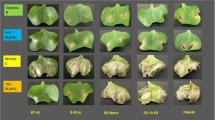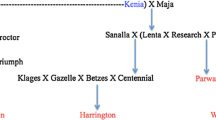Abstract
Inheritance studies of seedling and adult-plant resistance to blackleg [Leptosphaeria maculans (Desm.) Ces. et De Not.] in rapeseed (Brassica napus L.) were conducted using 49 families derived by intercrosses between 14 randomly chosen F2 plants from the cross cv “Maluka”(resistant) cv “Niklas” (susceptible), conforming to the North Carolina mating design II (NCM-II). Four concurrent experiments were performed, where plants from each family were: (I) Spray inoculated with a 105 pycnidiospores/ml suspension 10 days after germination and assessed 2-weeks later for cotyledon-lesion development, (II) As for (I), but assessed 12 weeks after inoculation for crown-canker development, (III) Wound-inoculated on the stems at growth stage 2.4–2.5 on the Harper and Berkenkamp scale and assessed for crown-canker development 5 weeks after inoculation, and (IV) Spray inoculated at growth stage 2.3–2.4 with a 105 pycnidiospores/ml suspension and assessed for crown-canker development nine weeks after inoculation. A L. maculans isolate possessing high levels of host specificity (MB2) was used in all inoculations. Seedling resistance was evaluated using a 0–5 cotyledon-lesion severity scale. Adult-plant resistance/susceptibility was evaluated using three separate measures of crown-canker size, i.e. the percentage of crown girdled (%G), external lesion length (E) and internal lesion area (%II). Quantitative genetic analysis of blackleg resistance using the NCM-II design revealed significant non-additive genetic variances for all measures of disease severity, in all four experiments, indicating the presence of strong dominance/epistasis at loci controlling blackleg resistance. The resistance to crown-canker development, after wound-inoculation of the stem, was found to possess the highest ratio of additive to non-additive genetic variance. Crown-canker development in mature plants of the NCM-II population was not related to the degree of cotyledon-lesion development at the seedling stage, indicating the limited value of the cotyledon test in screening for adult-plant blackleg resistance. The implications of these findings to breeding for resistance to blackleg in rapeseed are discussed.
Similar content being viewed by others
References
Barbetti MJ (1975) Effects of temperature on development and progression in rape of crown-canker caused by Leptosphaeria maculans. Aust J Exp Agric Anim Husb 15:705–708
Cargeeg LA, Thurling N (1979) Seedling and adult plant resistance to blackleg [Leptosphaeria maculans (Desm.) Ces. et de Not.] in spring rape (Brassica napus L.) Aust J Agric Res 30:37–46
Carter E (1982) Variation in resistance to Leptosphaeria maculans (Desm.) Ces.et de Not. between and within Brassica species. Master's thesis, University of Western Australia
Cockerham CC (1963) Estimation of genetic variances. In: Hanson WD, Robinson HF (eds) Statistical genetics and plant breeding. Proc Symp and Workshop, Committee on Plant Breeding and Genetics, Agricultural Board., Publ no. 982, Natl Acad Sci, NRC, Washington, pp 53–93
Delwiche PA (1980) Genetic aspects of blackleg (Leptosphaeria maculans) resistance in rapeseed (Brassica napus). PhD thesis, University of Wisconsin-Madison
Dion Y, Landry BS, Gugel RK, Seguin-Swartz G (1994) RFLP mapping of blackleg resistance on the canola genome. Blackleg News (Agriculture and Agri-Food Canada) No. 2. pp 1–3
Downey RK, Klassen AJ, Stringen GR (1980) Rapeseed and mustard. In: Fehr WR, Hadley HH (eds) Hybridization of crop plants. American Society of Agronomy Inc., and Crop Science Society of America Inc., USA, pp 495–509
Gladders P, Musa TM (1980) Observations on the epidemiology of Leptosphaeria maculans stem canker in winter oilseed rape. Plant Pathol 29:28–37
Hammond KE, Lewis BG (1987) Differential responses of oilseed rape leaves to Leptosphaeria maculans. Trans Br Mycol Soc 88:329–333
Hammond KE, Lewis BG, Musa TM (1985) A systemic pathway in the infection of oilseed rape plants by Leptosphaeria maculans. Plant Pathol 34:557–565
Harper FR, Berkenkamp B (1975) Revised growth stage key for Brassica campestris and B. napus. Can J Plant Sci 55:657–658
Helms K, Cruickshank IAM (1979) Germination- inoculation technique for screening cultivars of oilseed rape and mustard for resistance to Leptosphaeria maculans. Phytopathol Zeit 95:77–86
Kearsey MJ (1965) Biometrical analysis of a random mating population: a comparison of five experimental designs. Heredity 20:205–235
Mather K, Jinks JL (1971) Biometrical Genetics: the study of continuous variation. 2nd edn. Chapman and Hall, Great Britain
Mithen RF, Lewis BG, Fenwick GR (1987) Resistance of leaves of Brassica species to Leptosphaeria maculans. Trans Br Mycol Soc 88:525–531
Pang ECK, Halloran GM (1995) Adaptability and virulence specificity in Australian strains of blackleg [Leptosphaeria maculans (Desm.) Ces. et De Not.] on different host genotypes of rapeseed (Brassica napus L.). Aust J Agric Res 46:971–84
Pang ECK, Halloran GM (1996) The genetics of blackleg [Leptosphaeria maculans (Desm.) Ces. et De Not.] resistance in rapeseed (Brassica napus L.). I. Adult-plant resistance in F2 and first backcross populations. Theor Appl Genet 93:932–940
Thurling N, Venn LA (1977) Variation in the responses of rapeseed (Brassica napus and Brassica campestris) cultivars to blackleg (Leptosphaeria maculans) infection. Aust J Exp Agric Anim Husb 17:445–451
Wittern I, Kruger W (1985) Spore germination of Phoma lingam (Tode ex. Fr.) Desm. and methods to determine resistance of oilseed rape in the greenhouse. Phytopathol Zeit 113:113–124
Author information
Authors and Affiliations
Additional information
Communicated by G. Wenzel
Rights and permissions
About this article
Cite this article
Pang, E.C.K., Halloran, G.M. The genetics of blackleg [Leptosphaeria maculans (Desm.) Ces. et De Not.] resistance in rapeseed (Brassica napus L.). Theoret. Appl. Genetics 93, 941–949 (1996). https://doi.org/10.1007/BF00224097
Received:
Accepted:
Issue Date:
DOI: https://doi.org/10.1007/BF00224097




